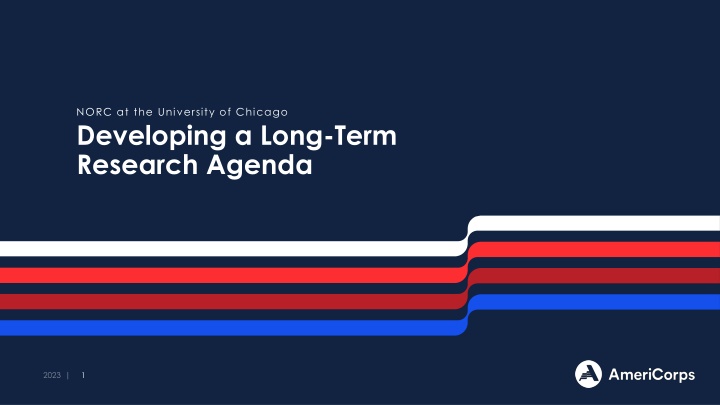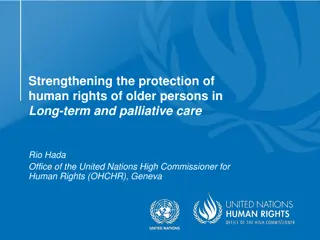Developing a Long-Term Research Agenda at NORC, University of Chicago
Explore the significance of establishing a long-term research agenda, understand the stages involved in building evidence of program effectiveness, and identify key considerations for developing a personalized research agenda. Learn why it is essential to have a structured research plan, how it aids in demonstrating program effectiveness, and the strategic allocation of evaluation resources for impactful outcomes.
Download Presentation

Please find below an Image/Link to download the presentation.
The content on the website is provided AS IS for your information and personal use only. It may not be sold, licensed, or shared on other websites without obtaining consent from the author.If you encounter any issues during the download, it is possible that the publisher has removed the file from their server.
You are allowed to download the files provided on this website for personal or commercial use, subject to the condition that they are used lawfully. All files are the property of their respective owners.
The content on the website is provided AS IS for your information and personal use only. It may not be sold, licensed, or shared on other websites without obtaining consent from the author.
E N D
Presentation Transcript
NORC at the University of Chicago Developing a Long-Term Research Agenda 1
Learning Objectives By the end of this presentation, you will be able to: Recognize the importance of building a long-term research agenda Identify the various stages in building evidence of a program s effectiveness Understand the key questions to consider prior to developing a long-term research agenda for your program
PART 1 Defining a Long-term Research Agenda
What is a Long-term Research Agenda? A long-term research agenda is a series of intentional or planned program evaluations and research tools that build towards addressing a research goal. Similar to a strategic plan, a research agenda generally spans over several years. A research agenda is unique and should be tailored to each individual program. A research agenda is a dynamic tool (i.e., a living document) that should be revised/updated based on new evidence, shifts in program direction, etc.
Long-term Research Agenda Research Goal Program evaluation Instrument and data collection systems development Performance measurement
Why is it Important to Have a Long-term Research Agenda? A research agenda sets clear goals for what program stakeholders want or need to know about the program years into the future A research agenda defines your destination, then identifies the supporting steps that will get you there A research agenda continues to build evidence of program effectiveness A research agenda demonstrates strategic investment of funds in evaluation activities
Build a Long-term Research Agenda What does a long-term research agenda look like? What do we want to have learned 5 years from now? 10 years from now? Work backwards: define your destination, then name the supporting steps that will get you there Each evaluation should build on what you learned previously If you invest evaluation money strategically, scarce resources can have a big impact 7
Example of a Long-term Research Agenda AmeriCorps Housing Assistance Program Goal: Demonstrate that the program has a positive impact on beneficiaries via an impact evaluation or quasi-experimental evaluation. Step 1: Collect program data, routinely, on family background characteristics and number of families served. Step 2: Process study: Is the program being implemented with fidelity to the model? Step 3: Collect pre/post outcome data each year via annual survey. Step 4: In addition to data collected from Steps 1&2, collect long-term outcomes data via follow-up survey (1 year post- program) Step 5: Local demand for program services exceeds the services provided by the program, so identify other local public and private sources providing services to similar families to serve as a comparison group and conduct a quasi-experimental design (QED study). 8
Example: Stages in a Long-term Research Agenda Quasi-experimental design (QED) Long term outcome data via follow-up survey Pre-post outcome data via survey (e.g., non- experimental outcome evaluation) Process evaluation Collect routine program data Program: AmeriCorps program provides housing assistance for low-income families. Research Goal: Demonstrate that the program has a positive impact on beneficiaries via a quasi- experimental design (QED)
What to Consider When Developing a Long-term Research Agenda Program maturity How long the program has been in operation Existing evidence base Evidence that has already been generated on the program that the long-term research agenda should build off Funder requirements and other stakeholder needs AmeriCorps has evaluation requirements for some of its grantees, and those requirements should affect a program s decisions about its long-term research agenda Sometimes the same evaluation can meet the needs and requirements of multiple funders
What to Consider When Developing a Long-term Research Agenda Long-term program goals A long-term research agenda should be designed to systematically provide information that supports a program s long-term strategic goals Long-term research goals Programs should have long-term research goals that relate to building evidence of effectiveness over time Evaluation budget The amount of the program s funding base that will set aside for evaluation activities each year or each grant period
Exercise Part I: Key Considerations in Developing a Long-term Research Agenda for Your AmeriCorps Program Your AmeriCorps program Program maturity Existing evidence Funder requirements Long-term program goals Long-term research goals Evaluation budget
PART 2 Building Evidence of Effectiveness
Building evidence of effectiveness Building Evidence of Effectiveness Evidence Based Stage 5: Attain causal evidence of positive program outcomes Stage 4: Obtain evidence of positive program outcomes Evidence Informed Stage 3: Assess program outcomes Stage 2: Ensure effective implementation Stage 1: Identify a strong program design
Stage 1: What is the Program Model and What is it Supposed to do? Evidence Based Stage 1: Identify a strong program design Stage 5: Attain causal evidence of positive program outcomes Stage 4: Obtain evidence of positive program outcomes Evidence Informed Stage 3: Assess program outcomes Stage 2: Ensure effective implementation Stage 1: Identify a strong program design Gather evidence to support program design (e.g., conduct a literature review and/or needs assessment) Develop logic model Pilot program
Stage 1: What is the Program Model and What is it Supposed to do? Evidence Based Stage 2: Ensure effective implementatio n Stage 5: Attain causal evidence of positive program outcomes Stage 4: Obtain evidence of positive program outcomes Evidence Informed Stage 3: Assess program outcomes Stage 2: Ensure effective implementation Stage 1: Identify a strong program design Output performance measurement Process evaluation
Stage 1: What is the Program Model and What is it Supposed to do? Evidence Based Stage 3: Assess program outcomes Stage 5: Attain causal evidence of positive program outcomes Stage 4: Obtain evidence of positive program outcomes Evidence Informed Stage 3: Assess program outcomes Stage 2: Ensure effective implementation Stage 1: Identify a strong program design Measure program outcomes (e.g., non- experimental evaluation design)
Stage 1: What is the Program Model and What is it Supposed to do? Evidence Based Stage 4: Obtain evidence of positive program outcomes Stage 5: Attain causal evidence of positive program outcomes Stage 4: Obtain evidence of positive program outcomes Evidence Informed Stage 3: Assess program outcomes Stage 2: Ensure effective implementation Stage 1: Identify a strong program design Impact evaluation (e.g., quasi-experimental design, experimental design)
Stage 1: What is the Program Model and What is it Supposed to do? Evidence Based Stage 5: Attain causal evidence of positive program outcomes Stage 5: Attain causal evidence of positive program outcomes Stage 4: Obtain evidence of positive program outcomes Evidence Informed Stage 3: Assess program outcomes Stage 2: Ensure effective implementation Stage 1: Identify a strong program design Outcome evaluation
Building Evidence of Effectiveness: Stages 1-5 Evidence Based Stage 5: Attain causal evidence of positive program outcomes Stage 4: Obtain evidence of positive program outcomes Evidence Informed Stage 3: Assess program outcomes Stage 2: Ensure effective implementation Stage 1: Identify a strong program design Impact Evaluation Outcome Evaluation Outcome Performance Measurement Output Performance Measurement Process evaluation Gather evidence that supports program design. Develop logic model Pilot program
Exercise Part II: Building evidence of effectiveness for your AmeriCorps program Exercise Part II: Building Evidence of Effectiveness for Your AmeriCorps Program Evidence Based Stage 5: Attain strong evidence of positive program outcomes Evidence Informed Stage 4: Obtain evidence of positive program outcomes Stage 3: Assess program outcomes Stage 2: Ensure effective implementation Stage 1: Identify a strong program design
PART 3 Example Scenarios
Scenario 1: Building a long-term research agenda for a new Senior Companion Program a New Senior Companion Program Scenario 1: Building a Long-term Research Agenda for Evidence Based Stage 5: Attain strong evidence of positive program outcomes Evidence Informed Stage 4: Obtain evidence of positive program outcomes Stage 3: Assess program outcomes Stage 2: Ensure effective implementation Stage 1: Identify a strong program design
Scenario 1: Logic Model for a Senior Companion Program (SCP) Process Outcomes OUTCOMES INPUTS ACTIVITIES OUTPUTS SHORT-TERM Changes in knowledge, skills, attitudes, opinions MEDIUM-TERM Changes in behavior or action that result from participants new knowledge LONG-TERM Meaningful changes, often in their condition or status in life What we invest What we do Direct products from program activities Older adults experience greater levels of independence. Funding Provide independent living services (transportation, nutrition/food support, assistance with medical appointments, etc.) 50 older adults received transportation services Older adults experience improved capacity for independent living. Older adults experience increased social and instrumental support. 4 FT Staff 45 older adults received nutrition/food support, 30 SCP volunteers Older adults experience increases in social support. Older adults experience decreases in stress, anxiety, and depression. Older adults experience increases in overall health and well-being. 30 older adults received assistance with medical appointments Training Provide companionship services SCP volunteers experience increased feelings of social- connectedness. SCP volunteers experience feelings of making a positive impact. SCP volunteers experience increases in overall health. 30 older adults received companionship services
Scenario 1: Key Considerations in Developing a Long-term Research Agenda New, Senior Companion Program Program maturity AmeriCorps grantee with no prior years of program implementation. Operating in only one community site. Existing evidence The program s evidence falls in the first stage on the continuum as it has conducted a literature review to determine best practices for implementing core service activities. No evaluations have been conducted on the program. Funder requirements AmeriCorps Seniors grantees are required to report national performance measures; grantees have no explicit evaluation requirements. Long-term program goals Achieve full program operation with efficiency and fidelity to the program s central model. Realize all expected program outcomes. Long-term research goals Generate data to facilitate program improvements and ensure an efficient, full operation of the program s service activities. Generate data on the program s short- and medium-term outcomes (see logic model). Evaluation budget 10% of the program s annual funding has been set aside for evaluation activities.
Scenario 1: Long-term Research Agenda for a Senior Companion Program (SCP) Evaluation activities Stage of evidence 1: Identify strong program design 2: Ensure effective implementation and develop data collection plan 1 Develop a logic model and a detailed program implementation plan. Create a data system to routinely collect performance measurement data and background data on program beneficiaries and SCP volunteers. Program staff and SCP volunteers begin routine data collection activities. Develop a survey to collect short-term outcome data, focusing on beneficiaries capacity for independent living and increases in social support. SCP volunteers administer pre/post surveys to program beneficiaries and analyze data. Conduct an internal process evaluation to determine if the program is being implemented with fidelity to the central model. Make data-driven adjustments to the program s implementation as needed. Conduct a non-experimental outcome evaluation using an external evaluator, measuring both short-term and medium-term outcomes. 2 3 3: Assess program outcomes 4 2: Ensure effective implementation 5 3: Assess program outcomes
Scenario 2: Building a long-term research agenda for a large, established AmeriCorps program for a Large, Established AmeriCorps Program Scenario 2: Building a Long-term Research Agenda Evidence Based Stage 5: Attain strong evidence of positive program outcomes Evidence Informed Stage 4: Obtain evidence of positive program outcomes Stage 3: Assess program outcomes Stage 2: Ensure effective implementatio n Stage 1: Identify a strong program design
Scenario 2: Example Logic Model for Large, Established, Environmental Restoration Program Outcomes Medium-Term Changes in behavior or action that result from participants new knowledge Improve habitat spaces for wildlife INPUTS ACTIVITIES OUTPUTS Short-Term Changes in knowledge, skills, attitudes, opinions Long-Term What we invest What we do Direct products from program activities Meaningful changes, often in their condition or status in life Funding Conduct forest enhancement and restoration Install 100,000 native trees and shrubs on public land Increase diversity and coverage of native plant species Maintain conservation of healthy, productive, sustainable ecosystems Staff Increase survival rate of native plant species and wildlife 200 AmeriCorps State and National members Complete up-keep activities to enable native plants to survive Reduce presence of invasive plant species Remove 50% of invasive plant species on 10 forest sites 200 non- AmeriCorps volunteers Research
Scenario 2: Key Considerations in Developing a Long- term Research Agenda Large, Established ASN Environmental Restoration Program AmeriCorps grantee in its second three-year AmeriCorps grant cycle. Already operating in multiple sites and expects to add additional service sites. Program maturity Established data collection processes to collect performance measurement output and outcome data. Conducted internal process evaluation yielding evidence that the program is being implemented with fidelity in most service sites. Existing evidence Large grantees must conduct an external impact evaluation by the end of their second grant cycle. Large grantees are required to submit an impact evaluation report AND an evaluation plan for a future evaluation with their re-compete application after completing two or more three-year cycles. Achieve and maintain fidelity of program implementation across all existing sites and any new service sites. Build stronger evidence of effectiveness to support future requests for higher levels of funding to expand program operations. Funder requirements Long-term program goals Conduct an external impact evaluation to assess the program s short- and medium-term outcomes. Four to six years is the minimum amount of time for program outcomes to be realized . For this reason, the grantee will submit a request for an alternative evaluation approach for timing considerations. 15% of the grantee s annual funding has been set aside for evaluation activities. Grantee is seeking additional outside funding for the impact evaluation. Long-term research goals Evaluation budget
Scenario 2: Long-term research agenda for large, established environmental restoration program Evaluation activities Grant cycle Stage of evidence 1 Conduct a quasi-experimental design (QED) study using an external evaluator, measuring all short- and medium-term outcomes over a six-year time frame and relative to a matched comparison group of sites (i.e., adjacent non-serviced areas that are similar to the pre-restoration conditions at the treatment sites). 5: Obtain evidence of positive program outcomes 2+3 2 Continue to collect and analyze output and outcome performance measurement data on an annual basis. 3: Assess program outcomes 2: Ensure effective implementati on 2, 3, 4, etc. 3 Conduct an internal process evaluation focusing on new service sites to determine if the program s new restoration projects are being implemented with fidelity to the central model. Make data-driven adjustments to the program s implementation as needed. 2
Part 4 Exercise
Exercise: Building evidence of effectiveness for your AmeriCorps program Your AmeriCorps Program Exercise: Building Evidence of Effectiveness for Evidence Based Stage 5: Attain strong evidence of positive program outcomes Evidence Informed Stage 4: Obtain evidence of positive program outcomes Stage 3: Assess program outcomes Stage 2: Ensure effective implementatio n Stage 1: Identify a strong program design
Exercise Part I: Key Considerations in Developing a Long-term Research Agenda for Your AmeriCorps Program Your AmeriCorps program Program maturity Existing evidence Funder requirements Long-term program goals Long-term research goals Evaluation budget
Exercise Part II: Building evidence of effectiveness for your AmeriCorps program Your AmeriCorps Program Exercise Part II: Building Evidence of Effectiveness for Evidence Based Stage 5: Attain strong evidence of positive program outcomes Evidence Informed Stage 4: Obtain evidence of positive program outcomes Stage 3: Assess program outcomes Stage 2: Ensure effective implementatio n Stage 1: Identify a strong program design
Exercise Part III: Long-term Research Agenda for Your AmeriCorps Program Evaluation activities Grant cycle Stage of evidence 1 2 3 4
Important Points to Remember A long-term research agenda is a developmental approach to evaluation whereby evidence of effectiveness is built over time. A long-term research agenda is unique and should be tailored to fit each individual program. There is value to building evidence at all stages along the continuum. A long-term research agenda should reflect an iterative process where evidence is built gradually over time.
Key Points to Consider When Developing a Long- term Research Agenda
Resources AmeriCorps Resources https://www.americorps.gov/grantees-sponsors/evaluation-resources The American Evaluation Association: http://www.eval.org The Evaluation Center: http://www.wmich.edu/evalctr/ Innovation Network s Point K Learning Center: http://www.innonet.org
Thank you! Carrie E. Markovitz, Ph.D. NORC at the University of Chicago markovitz-carrie@norc.org To contact the Office of Research and Instrument and data collection systems development Evaluation: evaluation@cns.gov























